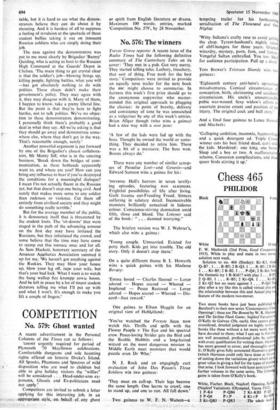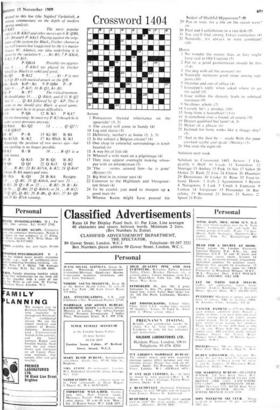Chess 465
PHILMOR
F. W. Markwick (2nd Prize, Good Cotnpanior 1915). White to play and mate in two moses solution next week.
Solution to no. 464 (Shedey): Kt-K5, thr Q-B7 . 1. . . B-B5 ; 2 B-Q3. 1 . R-B5 ; 2 B-K4
1 ... Kt-B5; 2 B-B2. 1 P-Q4; 2 R-K6. N the thematic try 1 B-Kt6!? with play 1 ... B-B5 2 Q-B3. 1 . . . R-B5; 2 Kt-Q4. 1 . . . Kt-B5 2 Kt-Q2 but no mate against 1 . . . P-Q4! play after a try like this is called virtual play a the relationship between this and Actual play is feature of the modem two-mover.
Two more books have just been published Batsford's in their new series `Contemporar) C Openings'; these are The Benoni by W. R. Harlst and The Sicilian Flank Game; Najdorf Variation O'Kelly de Galway (28s. each). One cannot gi‘e considered, detailed judgment on highly techn books like these without a lot more work than have devoted to them; what I can say is that t are well presented, professional jobs by aut with every qualification for writing them. Harlot has more ground to cover, and thoroughly cos it; O'Kelly gives fully annotated illustrative go (which Hartston could only have done at the of cutting down the variations given) which are great value in giving a feel for the types of Posa that arise. I look forward with keen anticipation further volumes in the same series. The Collo game is taken from O'Kelly's book.
White, Fischer. Black, Najdorf. Opening, Sid! (Najdorf Variation). (Olympiad, Varna 1962).
' 1 P-K4 P-QB4 2 Kt-K113 p.-Q3 3P-Q4 P x P 4 KtxP Kt-K 5 Kt-QB3 P-QB3 The whole book dewed to this line (the Najdorf Variation), a striking commentary on the depth of modern opening analysis. p-KR3 • The most popular reply is 6 B-KKt5 and other moves are 6 B-Q134, 6 p_B4 and 6 P-KKI3. Playing against the orig- inator of the system for Black, Fischer chooses a less well known line (suggested by the us master Wearer W. Adams); one idea underlying it is shown by the variation 6. . . Kt-B3; 7 P-KKt4, P-K3; 8 P-Kt5.
P-QKt4 Possibly too aggres-
...
sire. 6 . . . P-KKt3 (as played by Fischer himself as Black) is solid and good.
Kt-Q5 B-Kt2 7 .. . Kt< P is met hy 8 Q-133 with masked attack on the QR. Kt , Ktch KtPx Kt 9 P-QB4 PxP Safer 9. . . P-Kt5; 10 B-Q3, Kt-B3.
Il• P B x P? The critical moment. He should play 10 . . . Q-R4ch; and if 11 B-Q2 then II . . . Q-K4 followed by Qx KP. This it seems to me should give Black a good game; after the text he is in great difficulties.
0-0 P-Q4 12 R-K1 P-K4? Far too loosening; he must try P-K3 though he is under severe pressure anyway.
Q- R4ch Kt-Q2 13 . . . Q-Q2?; 14 8-QKt5!
B! P x R 15 Kt-B5 B-B4 Kt-Kt7ch K-K2 17 Kt-B5ch K-K1 Repeating the position of two moves ago-but now castling is no longer possible.
B-K3 B x B 18 . . . B Q5 is a little better.
P 8 Q-Kt3 20 R-QI R-R2 R-Q6 Q-Q1 22 Q-Kt3 Q-B2
22 . . . R-81; 23 Kt-Kt7ch, K-K2; 24 Q-K4! Uhreat R-K6 mate) and wins.
B Pch K-QI 24 B-K6 Resigns 24 . . . Q-Bl ; 25 Q-Kt6ch, and now 25 . . . K-K!; 26 Qx R or 25 . . . R-B2; 26 Bx Kt. Or 24 .. . Q-B4; 25 Q-Kt8ch; or 24 . . . R-Kt2; 25 Q-Q5, Q-B1; 26 R-B6, Q-Kt I ; 27 Kt-Q6 and 28 Kt-B7ch winning.







































 Previous page
Previous page